GENDERED CITIES
Studying gender inequality in street names
Year 2022
In Spain there are 1940 streets named after the famous writer Cervantes, the most commemorated man in the Spanish street map.
The most commemorated woman is the politician and women’s rights advocate Clara Campoamor, with 478 streets.
This high ratio of 4 to 1 in favor of the male figure can be generalized to the rest of Spanish male and female streets.
Most frequent Spanish street names
(male streets in green and female streets in purple)
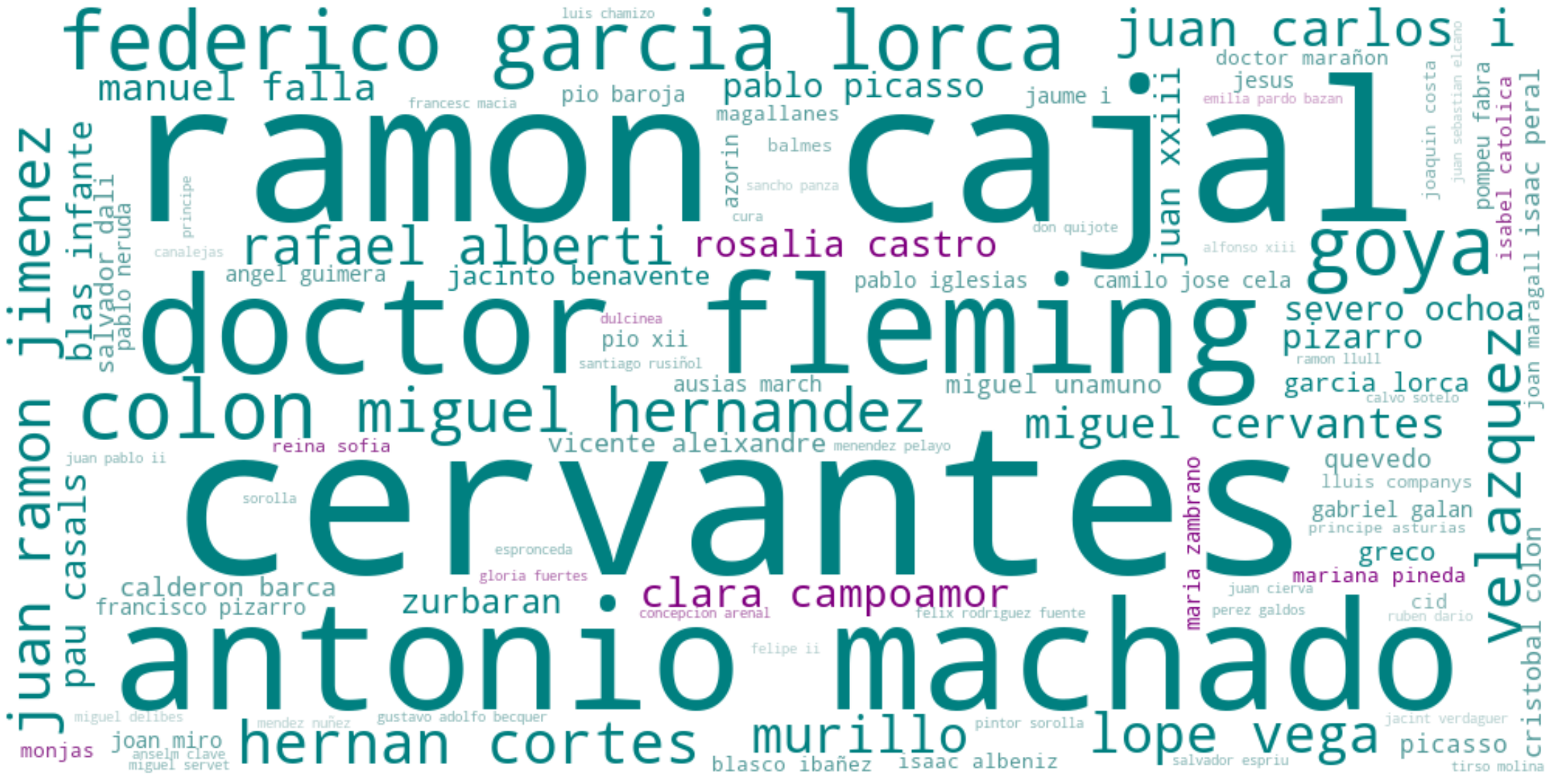
This map of Spain shows the percentage of female streets by province.
The province with the highest percentage is Granada, with 17.9%, and the one with the lowest percentage is Soria, with 8.6%.
Gendered street maps
We analyze 15 million street names to measure gender inequality in urban toponyms. We calculate for each Spanish municipality, from 2001 to the present, the percentage of streets named after women over those referring to people. Our results reveal a strong gender bias in Spanish cities: the proportion of female streets is 12.67% in 2022.
Female share in street names in the 20 largest Spanish cities
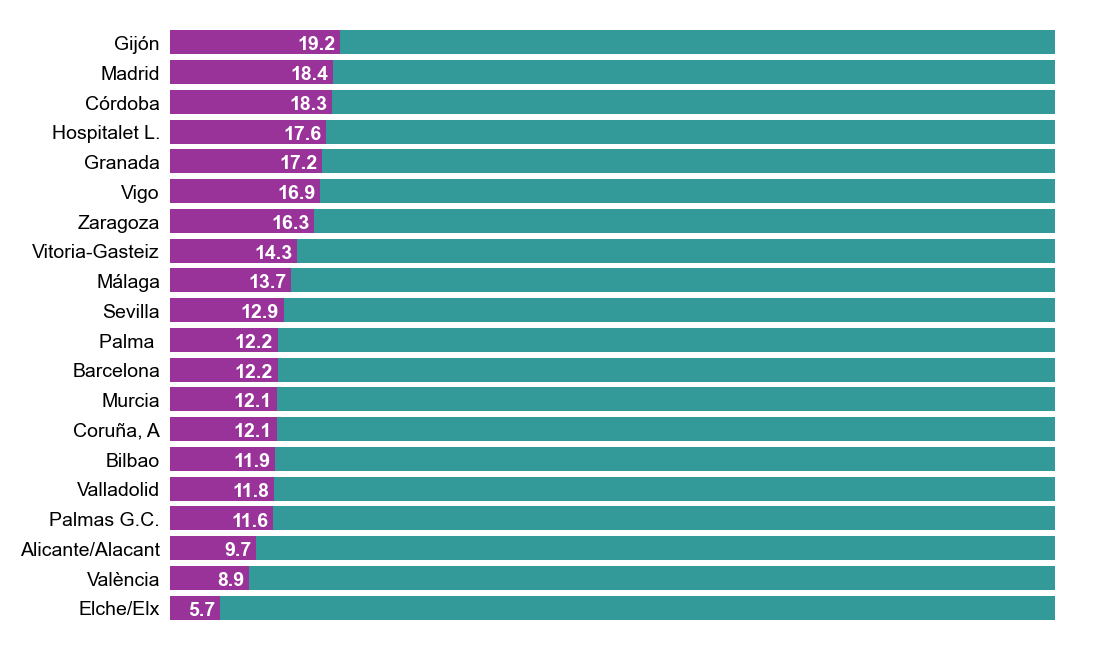
Santa Coloma de Gramenet is the Spanish city larger than 100,000 inhabitants with the least egalitarian street map, with a female share of 3.6%.
On the other side we find Fuenlabrada, with the most egalitarian street map and a female share of 34.4%.
In Loranca neighbourhood, there is a sector commemorating women and another commemorating men.
Guadalajara is the province capital with the greatest increase in the female share of street names in the last two decades, going from 5.8% in 2001 to 18.1% today.
This increase is largely due to new streets, located in the neighbourhood Las Cañas.
There are also some renamed streets, such as Brianda Mendoza Luna Street (former General Moscardó) and Margarita Salas Street (former Fernando Palanca).
In Guadalajara, as in other Spanish municipalities, the removal of Francoist street names has been used to commemorate women.
In the last few years, many city councils have realized the importance of naming streets after women. However, the female share increase is modest.
Slow evolution towards equality
In the study period, the proportion of female streets has experienced a slight increase, going from 9.8% in 2001 to 12.7% in 2022. This implies a slow evolution towards equality that would be achieved with 50%.
Focusing on new and renamed streets, the female share is significantly higher, ranging between 14.3% in 2015 and 35.1% in 2022. However, there is still a tendency to name streets favoring men over women, in a ratio of 2 to 1.
The evolution of the female share in street names from 2001 to the present
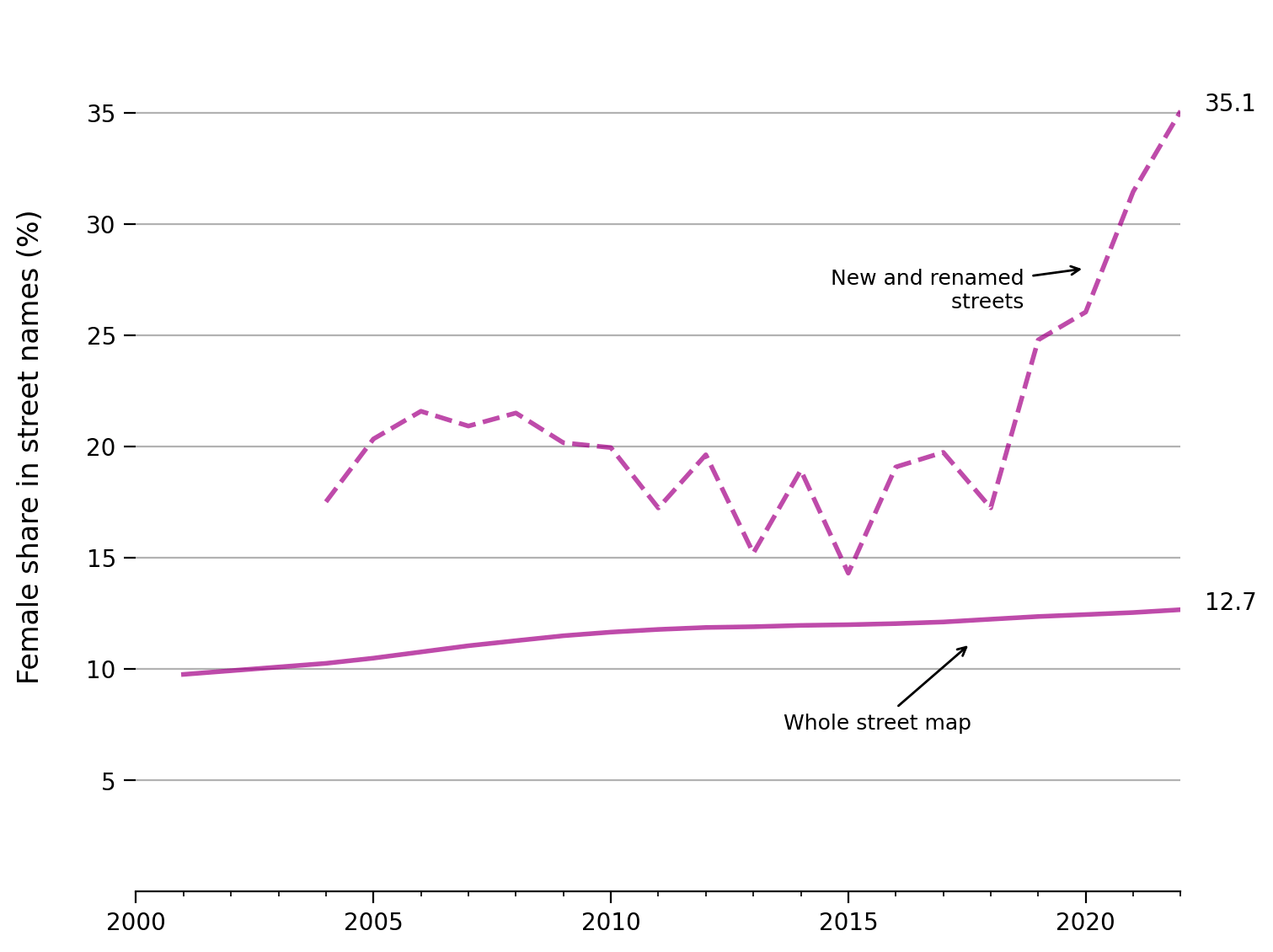
This recent increase in female streets has consisted mainly of new streets located in suburbs.
This phenomenon is observed in the city of Madrid, with a female share of 18.4%, where women names are relatively more frequent in areas far from the city center.
A higher proportion of female streets is also observed in satellite cities of large metropolitan areas, which have generally had more recent growth.
This is the case of Fuenlabrada (34.4% of female streets), Rivas-Vaciamadrid (34%), Torrejón de Ardoz (25.9%), Alcorcón (22.6%), Parla (23.8%) and Getafe (24.2%), which belong to the metropolitan area of Madrid and have a higher female share than the capital.
Fewer women in urban centers
Female streets have a more peripheral position within the urban fabric of our cities, being relatively less frequent in urban centers. The female share ranges from 9.4% in urban centers to 14.6% in the outlying areas of municipalities. Its lower presence in urban centers means a smaller geographic scope, reaching a lower percentage of the population.
Female share in street names according to the distance to the urban center

There are also significant differences between male and female streets in terms of religiosity.
In the neighbourhood Triana-Los Remedios in Seville, there are 41 streets named after virgin Mary (and her apparitions).
These streets do not commemorate real women but divine images.
In Seville, one out of every two female streets refers to Virgin Mary or a saint. In contrast, only one in ten male streets refers to a religious figure.
This pattern, although less pronounced, can be extrapolated to the rest of Spain.
If we included all religious streets in the calculation of the female share indicator, its value would increase from 12.7% to 17%.
We have removed religious names (related to God, Christ, Virgin Mary, and saints) from our analysis so that the results are not distorted by figures that do not reflect women's modern, egalitarian gender roles.
The street map as a mirror of society
There is a clear relationship between the proportion of female streets and the socioeconomic indicators of towns. Municipalities with a larger number of inhabitants, younger populations, a higher level of education, and more important service sectors have more women named on their streets. There also exists a correlation between the proportion of female streets and variables related to gender equality such as smaller gender gaps in labor participation, education, and domestic work.
Relationship between the female share in street names and socioeconomic indicators of municipalities

Relationship between the female share in street names and indicators of gender equality

The low proportion of women in the streetscape constitutes further evidence of their underrepresentation in the public sphere. In response to this, there exist numerous social movements and initiatives demanding a greater presence of women in street names.
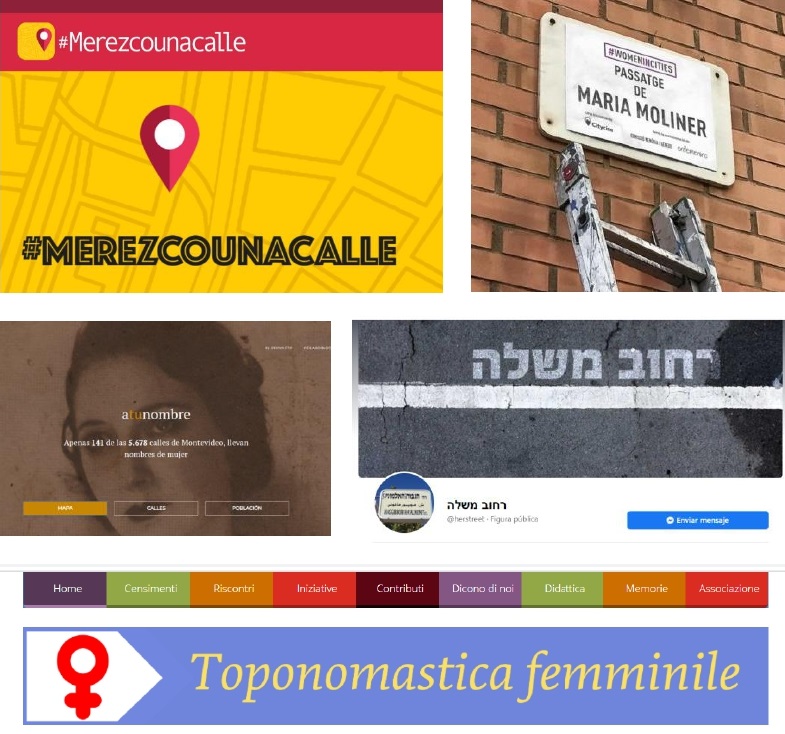
Methodological note
In this study, we develop a text analysis algorithm to classify streets according to their gender, if any. The classifier algorithm is based on a dictionary-based method and implemented as a rule-based system, using lists of thousands of women's names, men's names, surnames, famous people, etc.
The algorithm, subject to a continuous improvement process, is not error-free, but to the extent that errors identifying female streets are similar in relative magnitude to errors identifying male streets, errors offset one another and do not bias the female share. For this reason, errors in the female share indicator are expected to be small in large municipalities but can be high in small municipalities.
The data on Spanish street names have been obtained from the Electoral Census Street Map (www.ine.es), from year 2001 to the present.
See full study at: https://journals.sagepub.com/doi/10.1177/23998083211068844
See preprint at: https://osf.io/b9n4k/
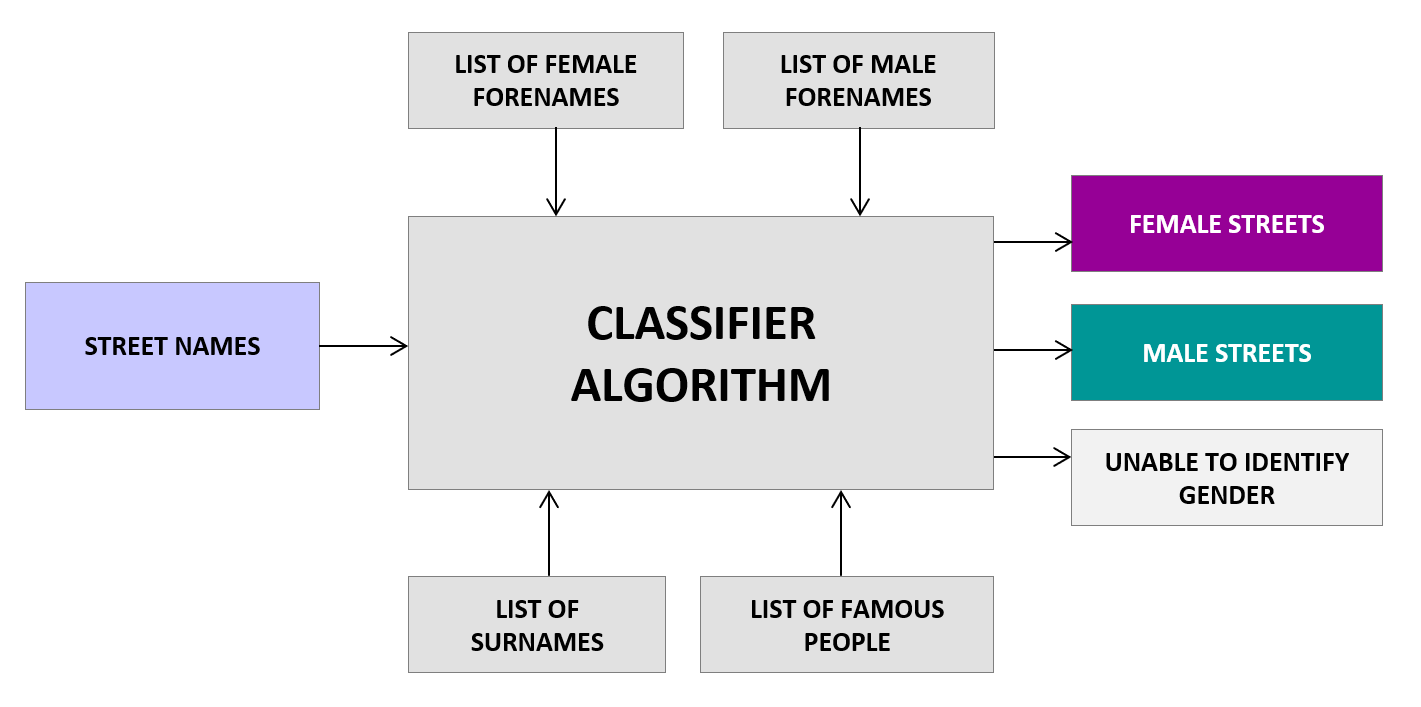
Did something go wrong? We would like to know. Click here.